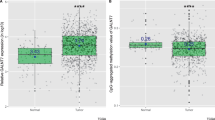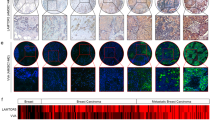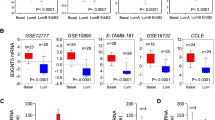Abstract
GALNT4 belongs to a family of N-acetylgalactosaminyltransferases, which catalyze the transfer of GalNAc to Serine or Threonine residues in the initial step of mucin-type O-linked protein glycosylation. This glycosylation type is the most complex post-translational modification of proteins, playing important roles during cellular differentiation and in pathological disorders. Most of the breast cancer subtypes are estrogen receptor positive, and hence, the estrogen pathway represents a key regulatory network. We investigated the expression of GalNAc-T4 in a panel of mammary epithelial cell lines and found its expression is associated with the estrogen status of the cells. FOXA1, a key transcription factor, functions to promote estrogen responsive gene expression by acting as a cofactor to estrogen receptor alpha (ERα), but all the aspects of this regulatory mechanism are not fully explored. This study found that knockdown of GALNT4 expression in human breast cancer cells attenuated the protein expression of ERα, FOXA1, and Cyclin D1. Further, our immunoprecipitation assays depicted the possibility of FOXA1 to undergo O-GalNAc modifications with a decrease of GalNAc residues in the GALNT4 knockdown cells and also impairment in the FOXA1–ERα association. Rescuing GALNT4 expression could restore the interaction as well as the glycosylation of FOXA1. Together, these findings suggest a key role for GalNAc-T4 in the estrogen pathway through FOXA1 glycosylation.




Similar content being viewed by others
Abbreviations
- GALNT4 :
-
Polypeptide N-acetylgalactosaminyltransferase 4
- ERα:
-
Estrogen receptor alpha
- ERβ:
-
Estrogen receptor beta
- FOXA1:
-
Forkhead box protein A1
- VVL:
-
Vicia Villosa Lectin
- UPR:
-
Unfolded protein response
- ERAD:
-
Endoplasmic reticulum-associated degradation
- CRD:
-
Carbohydrate recognition domain
References
Hart GW, Copeland RJ (2010) Glycomics hits the big time. Cell 143(5):672–676
Schjoldager KT, Clausen H (2012) Site-specific protein O-glycosylation modulates proprotein processing—deciphering specific functions of the large polypeptide GalNAc-transferase gene family. Biochim Biophys Acta 1820(12):2079–2094
Steentoft C et al (2013) Precision mapping of the human O-GalNAc glycoproteome through Precision mapping of the human O-GalNAc glycoproteome through SimpleCell technology. EMBO J 32(10):1478–1488
Madsen CB et al (2012) Cancer associated aberrant protein O-Glycosylation can modify antigen processing and immune response. PLoS One 7(11):e50139
Brockhausen I (2006) Mucin-type O-glycans in human colon and breast cancer: glycodynamics and functions. EMBO Rep 7(6):599–604
Gill DJ, Clausen H, Bard F (2011) Location, location, location: new insights into O-GalNAc protein glycosylation. Trends Cell Biol 21(3):149–158
Park JH et al (2011) Polypeptide N-acetylgalactosaminyltransferase 6 Disrupts mammary acinar morphogenesis through O-glycosylation of Fibronectin. Neoplasia 13(4):320–326
Park JH et al (2010) Critical roles of mucin 1 glycosylation by transactivated polypeptide N-acetylgalactosaminyltransferase 6 in mammary carcinogenesis. Cancer Res 70(7):2759–2769
American Cancer Society (2013) Breast cancer facts & figures 2013–2014. American Cancer Society, Atlanta
Wright PK et al (2009) Estrogen regulates vesicle trafficking gene expression in EFF-3, EFM-19 and MCF-7 Breast Cancer Cells. Int J Clin Exp Pathol 2(5):463–475
Neve RM et al (2006) A collection of breast cancer cell lines for the study of functionally distinct cancer subtypes. Cancer Cell 10(6):515–527
Chacko BK et al (2011) Endothelial Surface N-Glycans mediate monocyte adhesion and are targets for anti-inflammatory effects of peroxisome proliferator-activated receptor γ ligands. J Biol Chem 286(44):38738–38747
Eeckhoute J et al (2006) A cell-type-specific transcriptional network required for estrogen regulation of cyclin D1 and cell cycle progression in breast cancer. Genes Dev 20(18):2513–2526
Augello MA, Hickey TE, Knudsen KE (2011) FOXA1: master of steroid receptor function in cancer. EMBO J 30(19):3885–3894
Williamson EA et al (2006) BRCA1 and FOXA1 proteins coregulate the expression of the cell cycle-dependent kinase inhibitor p27(Kip1). Oncogene 25(9):1391–1399
Wu C et al (2010) N-Acetylgalactosaminyltransferase-14 as a potential biomarker for breast cancer by immunohistochemistry. BMC Cancer 10:123
Wagner KW et al (2007) Death-receptor O-glycosylation controls tumor-cell sensitivity to the proapoptotic ligand Apo2L/TRAIL. Nat Med 13(9):1070–1077
Lee J et al (2014) Unraveling the regulatory connections between two controllers of breast cancer cell fate. Nucleic Acids Res 42(11):6839–6849
Balázsi G, van Oudenaarden A, Collins JJ (2011) Cellular decision-making and biological noise: from microbes to mammals. Cell 144(6):910–925
Wang ZQ et al (2014) Role of the polypeptide N-acetylgalactosaminyltransferase 3 in ovarian cancer progression: possible implications in abnormal mucin O-glycosylation. Oncotarget 5(2):544–560
Fullwood MJ et al (2009) An oestrogen-receptor-alpha-bound human chromatin interactome. Nature 462(7269):58–64
Tokunaga E et al (2014) Molecular mechanisms regulating the hormone sensitivity of breast cancer. Cancer Sci 105(11):1377–1383
Hurtado A et al (2011) FOXA1 is a key determinant of estrogen receptor function and endocrine response. Nat Genet 43(1):27–33
Ross-Innes CS et al (2012) Differential oestrogen receptor binding is associated with clinical outcome in breast cancer. Nature 481(7381):389–393
Gong C et al (2015) FOXA1 repression is associated with loss of BRCA1 and increased promoter methylation and chromatin silencing in breast cancer. Oncogene 34(39):5012–5024
Manavathi B et al (2013) Derailed estrogen signaling and breast cancer: an authentic couple. Endocr Rev 34(1):1–32
Balogh P et al (2013) Estrogen receptor alpha is expressed in mesenteric mesothelial cells and is internalized in caveolae upon freund’s adjuvant treatment. PLoS One 8(11):e79508
Mehta RJ et al (2012) FOXA1 is an independent prognostic marker for ER-positive breast cancer. Breast Cancer Res Treat 131(3):881–890
Manavathi B, Samanthapudi VS, Gajulapalli VN (2014) Estrogen receptor coregulators and pioneer factors: the orchestrators of mammary gland cell fate and development. Front Cell Dev Biol 2:34
Gill DJ et al (2010) Regulation of O-glycosylation through Golgi-to-ER relocation of initiation enzymes. J Cell Biol 189(5):843–858
Gill DJ et al (2013) Initiation of GalNAc-type O-glycosylation in the endoplasmic reticulum promotes cancer cell invasiveness. Proc Natl Acad Sci USA 110(34):E3152–E3161
Bard F et al (2003) Src Regulates Golgi Structure and KDEL receptor-dependent retrograde transport to the endoplasmic reticulum. J Biol Chem 278(47):46601–46606
Hassan H et al (2000) The lectin domain of UDP-N-acetyl-D-galactosamine:polypeptideN-acetylgalactosaminyltransferase-T4 directs its glycopeptide specificities. J Biol Chem 275(49):38197–38205
Bennett EP et al (1998) Cloning of a human UDP-N-acetyl-α-D-galactosamine:polypeptideN-Acetylgalactosaminyltransferase that complements other GalNAc-transferases in complete O-glycosylation of the MUC1 tandem repeat. J Biol Chem 273(46):30472–30481
Housley MP et al (2008) O-GLCNAC Regulates FoxO activation in response to glucose. J Biol Chem 283(24):16283–16292
Wells L, Vosseller K, Hart GW (2001) Glycosylation of nucleocytoplasmic proteins: signal transduction and O-GlcNAc. Science 291(5512):2376–2378
Barondes SH et al (1994) Galectins: a family of animal beta-galactoside-binding lectins. Cell 76(4):597–598
Goletz S, Hanisch FG, Karsten U (1997) Novel alphaGalNAc containing glycans on cytokeratins are recognized invitro by galectins with type II carbohydrate recognition domains. J Cell Sci 110(14):1585–1596
Funakoshi Y, Suzuki T (2009) Glycobiology in the cytosol: the bitter side of a sweet world. Biochim Biophys Acta (BBA) 1790(2):81–94
Hirayama H et al (2010) Free oligosaccharides to monitor glycoprotein endoplasmic reticulum-associated degradation in saccharomyces cerevisiae. J Biol Chem 285(16):12390–12404
Alonzi DS et al (2008) Glucosylated free oligosaccharides are biomarkers of endoplasmic- reticulum alpha-glucosidase inhibition. Biochem J 409(2):571–580
Acknowledgments
This study was supported by grants from the National Program on Key Basic Research Project (973 Program) (No. 2012CB822103), the National Natural Science Foundation of China (No. 31170774, 31570802), the Fundamental Research Funds for the Central Universities and Development Fund for Collaborative Innovation Center of Glycoscience of Shandong University. We thank Professors Baiqu Huang (Northeast Normal University Changchun, China) and Eric Paul Bennett (Copenhagen center for Glycomics, Denmark) for their collaboration.
Author information
Authors and Affiliations
Corresponding author
Ethics declarations
Conflict of interest
The authors declare that they have no conflict of interest.
Electronic supplementary material
Below is the link to the electronic supplementary material.
Supplementary material 1
Human glycosylation array. The clustergram represents fold-regulation of 84 glycosyltransferases in three mammary epithelial cells MCF10A, T47D and MDAMB231, including GALNT4 which is the first glycosyltransferase on the top of this representation. Note that MCF10A was considered as control. Supplementary material 1 (TIFF 9311 kb)
Rights and permissions
About this article
Cite this article
Niang, B., Jin, L., Chen, X. et al. GalNAc-T4 putatively modulates the estrogen regulatory network through FOXA1 glycosylation in human breast cancer cells. Mol Cell Biochem 411, 393–402 (2016). https://doi.org/10.1007/s11010-015-2601-1
Received:
Accepted:
Published:
Issue Date:
DOI: https://doi.org/10.1007/s11010-015-2601-1




